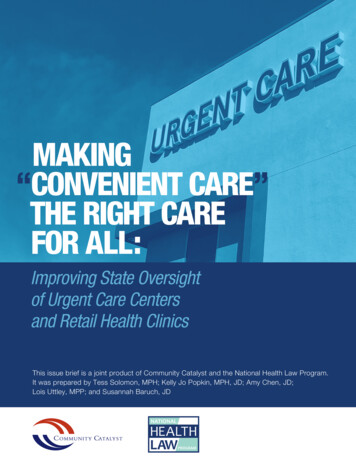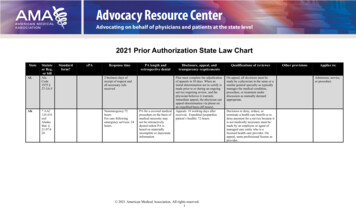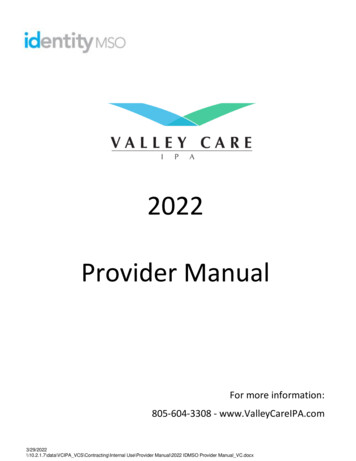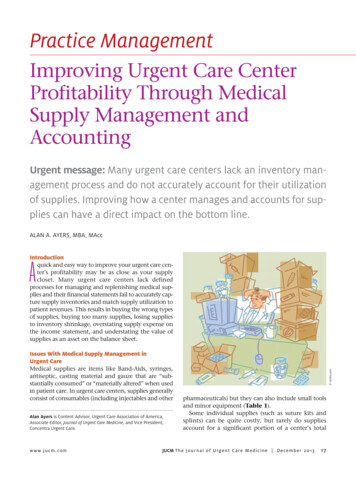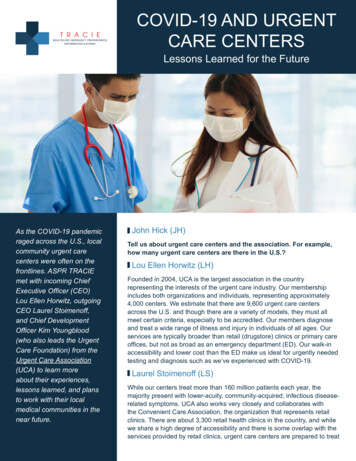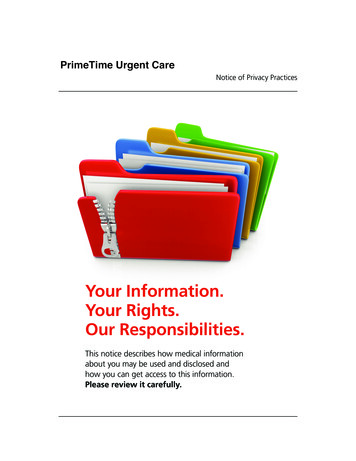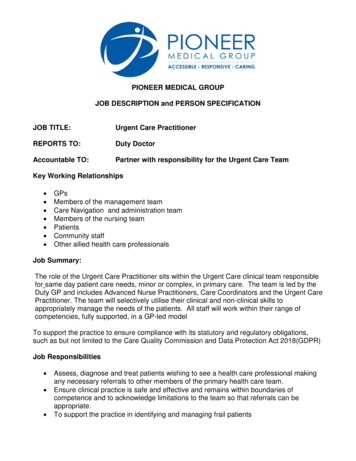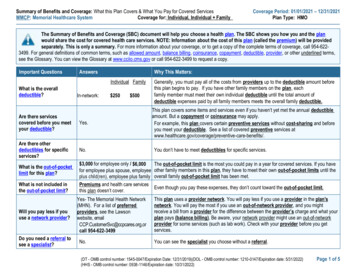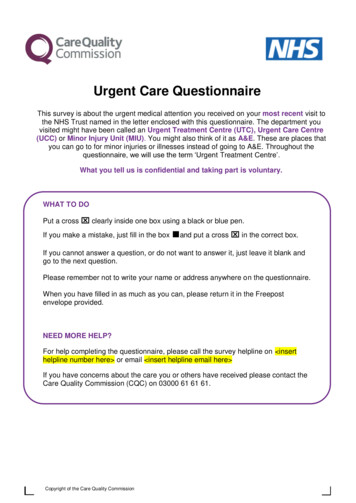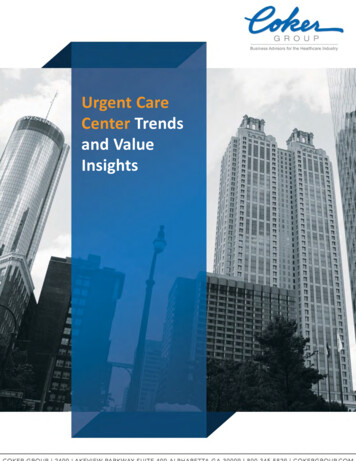
Transcription
Urgent CareCenter Trendsand ValueInsights
About the AuthorDAVID WALLINESENIOR MANAGERINFO@COKERGROUP.COM678.832.2002David Walline is a senior manager in Coker Group’sfinance, operations and strategy group, with aspecific focus on business valuation. His businessvaluation career spans over a decade, with the pasteight years focused on the valuation of entitieswithin the healthcare industry.
Contents4Introduction5What is an Urgent Care Center?9Current Transaction Environment13In Conclusion14Sources
In a time when our nation’s healthcare deliveryprocesses are at a point of unprecedentedchange in clinical practice and policy, urgent careclinics serve an essential role. They can provideurgent and primary care services to communitieswhile also providing relief for overcrowdedemergency departments. To this end, urgentcare clinics continue to experience materialgrowth driven by their convenience, high-qualitystandards of care, and demonstrated ability tolower the cost of and enhance access to care incommunities across America. This growth hasfueled an increase in transactions within theurgent care space.4
What is an urgentcare center?
The Urgent Care Associationof America (UCAOA) definesan urgent care center as amedical clinic with expandedhours that is speciallyequipped to diagnose andtreat a broad spectrum of nonlife or limb-threateningillnesses and injuries. Urgentcare centers are typicallyenhanced by onsite radiologyand laboratory services andoperate in a location distinctfrom a freestanding orhospital-based emergencydepartment. Urgent carecenters accept unscheduled,walk-in patients seekingmedical attention during allposted hours of operation.16
Urgent care centers primarily treat injuries orillnesses requiring immediate care, but notserious enough to require an emergencydepartment visit. Urgent care centers aredistinguished from similar ambulatory healthcarecenters, such as emergency departments andconvenient care clinics, by their scope ofconditions treated and available facilities onsite.The scope of services in an urgent care center isbroader and includes treatment of wounds,injuries, fractures, asthma attacks and mildconcussions. There are an estimated 8,774 urgentcare centers in the United States.27
Both the UCAOA and the American Academy of Urgent CareMedicine (AAUCM) have established criteria for urgent carecenters and the physicians that operate them. Each share similarqualifying criteria including:Must accept walk-in patients during business hoursTreat a broad spectrum of illnesses and injuries, as well asperform minor medical proceduresHave a licensed physician operating as the medical directorBe open 7 days a weekHave on-site diagnostic equipment, including phlebotomy and xrayContain multiple exam roomsVarious ethical and business standardsContain a procedure room where stitches could be placed, a castbe put on a leg, or even a minor surgical procedure if it is not toorisky and can be done under a local anesthetic.Contain communication lines with local hospitals so that patientswho need transfer to an emergency room have easy access8
Current transactionenvironment
As the healthcare industry continues to shift to value-basedreimbursement, urgent care centers continue to demonstrate theirability to provide a high quality of care, lower cost, setting formany patients. This focus of urgent care centers has made them atarget of acquisition by national urgent care operators, healthsystems, and private equity back investors. Growth is also beingstimulated by a well-documented shortage of primary carephysicians. Physician demand is expected to steeply accelerate,with an anticipated shortfall of 40,000 primary care physicians by2025. 3Although many factors contribute to the value of a specificurgent care center, Coker has identified two critical areasof focus for purchasers:Operational efficiencies driven by thecenter’s staffing modelThe number of locations the subject centeroperates10
STAFFINGIt will not come as a surprise to those involved with urgent care centers thatthe most critical component to success is finding the right staffing structure.Unlike traditional primary care practices, which largely have a scheduledpatient base, urgent care centers operate on an unscheduled walk-in patientbasis. Furthermore, urgent care centers often also have hours that extendbeyond that of traditional primary care practices. The result of longer hours,and an unscheduled patient base, is that urgent care centers must always bestaffed to meet the health needs of the communities they serve (i.e., quicklyand efficiently treating patients as they come into the center) while notoverstaffing such that providers are underutilized. Strategies that we haveseen implemented to address these operational hurdles include:1. Many centers offset the uncertainly related to daily patient volume byoffering both walk-in and scheduled patient visits. Although the billingfor the respective services differ, and as such, there is an addedadministrative burden on this strategy, it can often smooth-out aprovider’s day and productivity.2. Although many urgent care centers will always have a physician coveringshifts, mid-level providers are heavily utilized to see most patients. Thisstrategy allows for lower-cost providers to be staffed while still providingcare for more acute patients through a physician. Related to the staffingof urgent care centers, we have observed that nurse practitioners arebecoming increasingly independent as the healthcare industry respondsto primary care shortages and healthcare access issues.Ultimately, urgent care centers must have a good pulse for their patient basesuch that they can staff most efficiently from both a quality of careperspective and to maintain sufficient cash flow.11
NUMBER OF LOCATIONSInvestors place higher value on centersthat operate multiple locations within amarket. The economies of scaleassociated with multi-locationoperations are seen within payornegotiations, supply contractnegotiations, and allow centers to flextheir staff across multiple locations.Additionally, as there are centralizedmanagement and billing servicesprovided, the operating margin of thesecenters is typically higher. From avaluation perspective, having operationsdiversified across multiple locationswithin a market or region also decreasesthe inherent risk of the subject entity. Asrisk and value are directly correlated(lower risk, higher value, and viceversa), multi-location centers generallyhave a higher valuation multiple ascompared to single location entities.12
IN CONCLUSIONAlthough numerous factors will impact thevaluation of a specific urgent care center, thecurrent market is primed for a higher volume ofurgent care transactions at increased valuationmultiples. This trend is expected to continue asvalue-based reimbursement models continue toproliferate, and investors search for quality care ina lower-cost setting. As is the case with any entity,the greater diversification and operationalefficiencies that can be achieved, the moreattractive the entity will be to an investor. In thecase of urgent care centers, this generally falls totheir staffing model and ability to scale theiroperations to multiple locations within a market.13
Sources1.Urgent Care Association, UCAOA, https://www.ucaoa.org/.2.“2018 Survey Responses Covering 2017 Calendar Year.” Urgent Care Association,UCAOA, hmarkSurvey18.pdf?ver siciansupplyanddemandthrough2025keyfindings.pdf .14
The Urgent Care Association of America (UCAOA) defines an urgent care center as a medical clinic with expanded hours that is specially equipped to diagnose and treat a broad spectrum of non-life or limb-threatening illnesses and injuries. Urgent care centers are typically enhanced by onsite radiology and laboratory services and
